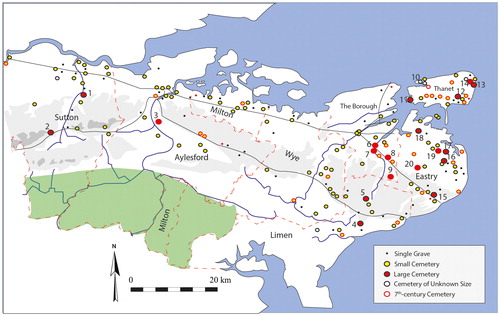Figures & data
FIG 1. Saltwood, Kent, Note the large clusters of graves which focus on Bronze-Age ring ditches. The trackway has prehistoric origins and remained in use until the 19th century, so the early Anglo-Saxons would have accessed these graves from different places. Redrawn after Brooks and Reynolds Citation2011. © D Sayer.
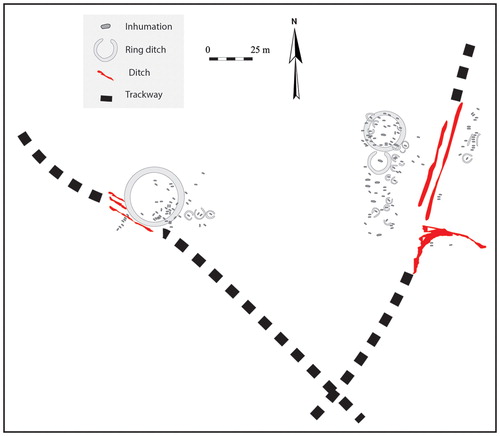
FIG 2. Cemeteries included in this study: 1 Apple Down, West Sussex, 2 Abingdon, Oxfordshire, 3 Barrington, Cambridgeshire, 4 Beckford B, Hereford and Worcester, 5 Berinsfield, Oxfordshire, 6 Blacknall Field, Wiltshire, 7 Broughton Lodge, Nottinghamshire, 8 Castledyke South, Lincolnshire, 9 Dover Buckland, Kent, 10 Empingham II, Rutland, 11 Finglesham, Kent, 12 Great Chesterford, Essex, 13 Kingsworthy, Hampshire, 14 Lechlade, Oxfordshire, 15 Norton, Cleveland, 16 West Heslerton, North Yorkshire, 17 Alton, Hampshire, 18 Alwalton, Cambridgeshire, 19 Beckford A, Hereford and Worcester, 20 Bergh Apton, Norfolk, 21 Coddenham, Suffolk, 22 Deal, Kent, 23 Didcot, Oxfordshire, 24 Dinton, Buckinghamshire, 25 Droxford, Hampshire, 26 Empingham I, Rutland, 27 Gunthorpe, Peterborough, 28 Holborough Hill, Kent, 29 Lyminge, Kent, 30 Marina Drive, Dunstable Bedfordshire, 31 Market Lavington, Wiltshire, 32 Meonstoke, Hampshire, 33 Melbourn, Cambridgeshire, 34 Morning-Thorpe, Norfolk, 35 Portway Andover, Hampshire, 36 Ports Down, Hampshire, 37 Orpington, Kent, 38 Sewerby, East Yorkshire, 39 Wakerley, Northamptonshire, 40 Westgarth Gardens, Suffolk, 41 Winterbourne Gunner, Wiltshire. Drawn by D Sayer ©.
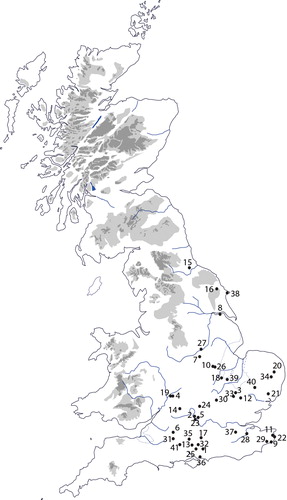
FIG 3. Pie chart showing the proportions of children, infants and adults found in large cemeteries with over 100 graves. Drawn by D Sayer ©.
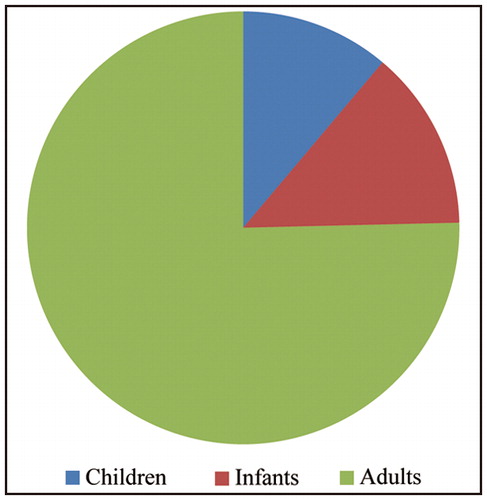
Table 1. Sixteen early Anglo-Saxon inhumation cemeteries with over 100 graves.
Table 2. Twenty-five early Anglo-Saxon cemeteries with less than 100 graves.
Table 3. Chi-Square investigation of infants in early Anglo-Saxon cemeteries
Table 4. Chi-Square investigation of children in early Anglo-Saxon cemeteries
Table 5. Chi-Square infants in early Anglo-Saxon cemeteries with numerical outliers removed1
FIG 4. Pie chart showing the proportions of children, infants and adults found in small cemeteries with less than 100 graves. Drawn by D Sayer ©.
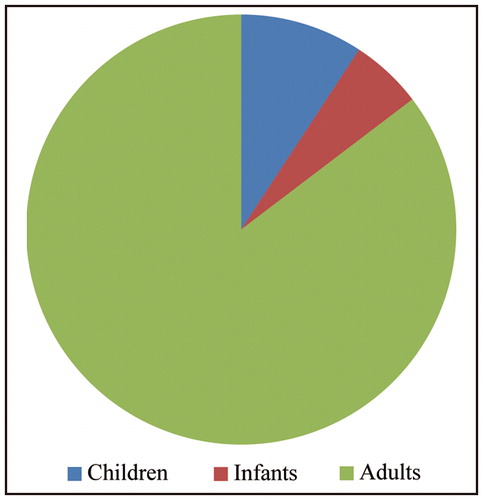
FIG 5. Proportions of infants and children in 41 cemeteries displayed as a histogram and arranged according to the number of infants. Cemeteries with over 100 graves are highlighted in red. Notice the increased number of these cemeteries where there are greater numbers of infants. Drawn by D Sayer ©.
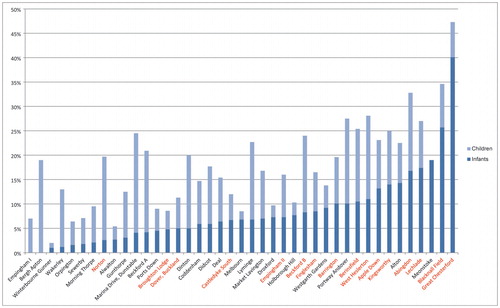
FIG 6. Top: Apple Down, West Sussex. This illustration shows the majority of inhumation graves, cremations are not included because age determination is impossible. Note the concentration of older adults and infants marked by the arrow. Bottom: Berinsfield, Oxfordshire. Berinsfield has two groups of graves oriented S/N and W/E and it also has two distinct concentration of infants and children marked with the arrows. Drawn by D Sayer ©.
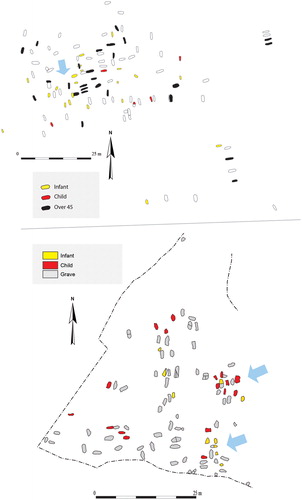
FIG 7. Top: Great Chesterford, Essex. About 75% of this cemetery has been excavated; note the two zones of children and infants each with concentrations of infant burials. Bottom: Westgarth Gardens, Suffolk. This site has single focus of infants and children in the centre adjacent to the older adults. Drawn by D Sayer ©.
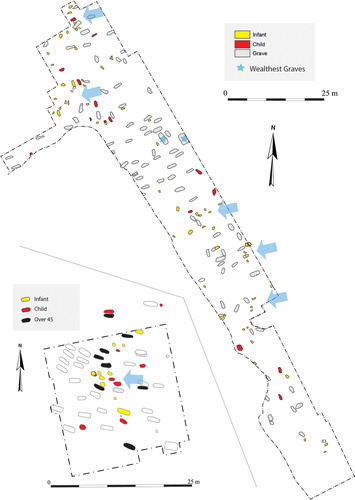
FIG 8. The Avon Valley, large cemeteries are spaced along the Avon hemmed by smaller sites along this boundary between two cultural zones. 1 Beckford B, 2 Bridford, 3 Alverton, 4 Wasperton and 5 Baginton. After Scheschkewitz Citation2006, 11. © D Sayer.
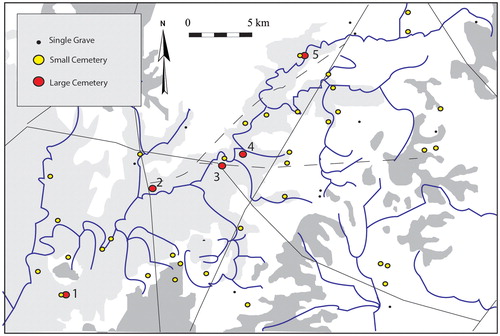
FIG 9. Kent with lathes, major Roman roads and rivers marked. Not the position of large cemeteries in west Kent with one or two to a lath each hemmed by small sites focus around a Roman road or river. In east Kent the large cemeteries are also hemmed by smaller ones but they also seem to mark the coast as a boundary. 1 Riseley, 2 Polhill, 3 Eccles, 4 Saltwood, 5 Lyminge, 6 Bifrons, 7 Bishopsbourne, 8 Kingston, 9 Breach Downs, 10 Brooksend, 11 Sarre, 12 Ozengell, 13 Broadstairs, 14 Peters Tip, 15 Dover Buckland, 16 Beacon Hill, 17 Finglesham, 18 Gilton, 19 Updown, 20 Sibertswold/Barfriston. After Richardson Citation2005; Brookes Citation2011. © D Sayer.
